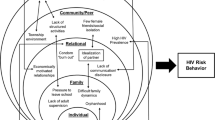Abstract
The purpose of this study was to determine how initial HIV prevention efforts for homeless youth were received and to determine areas where homeless youth's beliefs and behaviors continue to put them at risk for HIV infection. Interviews were conducted with 289 Seattle homeless youth. Youth reported using condoms with casual partners during vaginal and anal sex and with clients during oral, anal and vaginal sex. Condoms are often not used during vaginal sex with main partners or during oral sex with casual or main partners. Knowledge of HIV protective strategies differed according to youth's behavioral characteristics with heterosexual youth having the weakest knowledge of HIV protective strategies especially compared with young men who have sex with men. There is room for improvement in youth's knowledge and beliefs about HIV.
Similar content being viewed by others
REFERENCES
Athey JL. HIV infection and homeless adolescents. Child Welfare 1991; 70:517-528.
Pennbridge JN, Freese TE, MacKenzie RG. High-risk behaviors among male street youth in Hollywood, California. AIDS Education and Prevention 1992; Supplement:24-33.
D'Augelli AR, Bingham CR. Interventions to prevent HIV infections in young adolescents. In Richard M. Lerner (Ed.) et al. Early adolescence: Perspectives on research, policy, and intervention. Hillsdale, NJ: Lawrence Erlbaum Associates, Inc., 1993, pp. 353-368.
Kral, AH, Molnar, BE, Booth, RE, Watters, JK. Prevalence of sexual risk behaviour and substance use among runaway and homeless adolescents in San Francisco, Denver and New York City. International Journal of STD & AIDS 1997; 8:109-117.
Clatts, MC, Rees Davis, W, Sotheran, JL, Atillasoy, A. Correlates and distribution of HIV risk behaviors among homeless youths in New York City: Implications for prevention and policy. Child Welfare 1998; 77:195-207.
DiClemente RJ. Epidemiology of AIDS, HIV prevalence, and HIV incidence among adolescents. Journal of School Health 1992; 62:325-330.
Fisher JD, Fisher WA. Changing AIDS-Risk Behavior. Psychological Bulletin 1992; 111:455-474.
Farrow JA, Deisher RW, Brown R, Kulig JW, Kipke MD. Health and Health Needs of Homeless and Runaway Youth. Journal of Adolescent Health 1992; 13:717-726.
Stevenson HC, Davis G, Weber E, Weiman D, Abdul-kabir S. HIV prevention beliefs among urban African-American youth. Journal of Adolescent Health 1995; 16:316-323.
Tenner AD, Trevithick LA, Wagner V, Burch R. Seattle Youth Care's prevention, intervention, and education program: A model of care for HIV-positive, homeless, and at-risk youth. Journal of Adolescent Health 1998; 23:96-106.
Author information
Authors and Affiliations
Rights and permissions
About this article
Cite this article
Wagner, L.S., Carlin, L., Cauce, A.M. et al. A Snapshot of Homeless Youth in SeattleampColon; Their Characteristics, Behaviors and Beliefs about HIV Protective Strategies. Journal of Community Health 26, 219–232 (2001). https://doi.org/10.1023/A:1010325329898
Issue Date:
DOI: https://doi.org/10.1023/A:1010325329898




